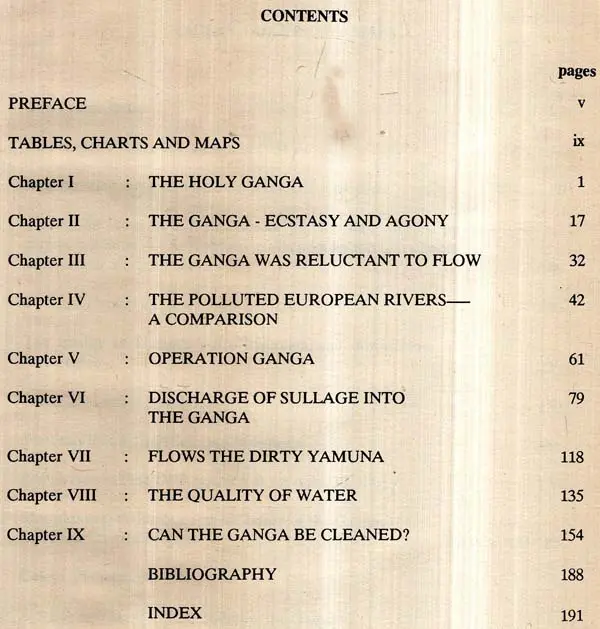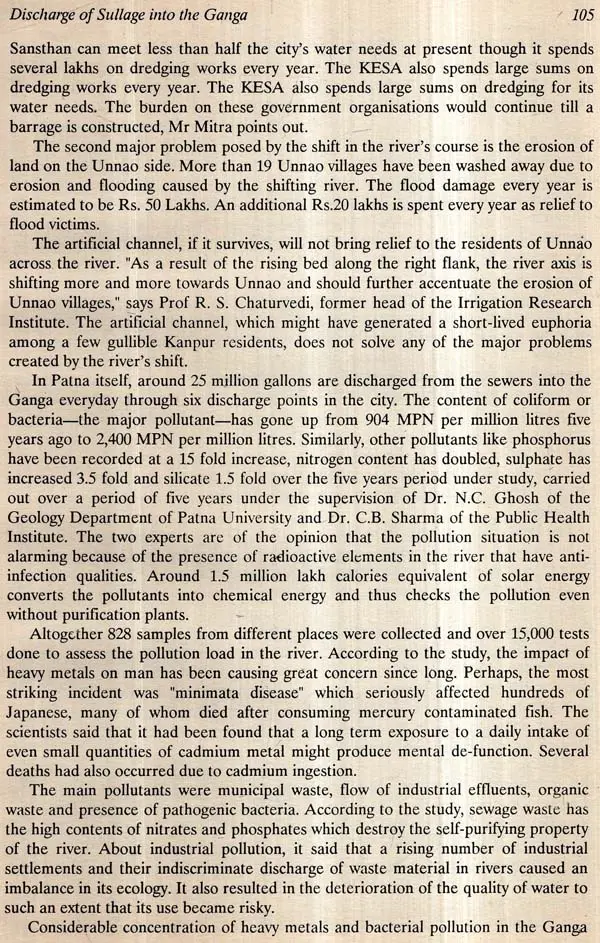
Can The Ganga Be Cleaned? (An Old And Rare Book)
Book Specification
| Item Code: | UAL006 |
| Author: | Brojendra Nath Banerjee |
| Publisher: | B.R. Publishing Corporation |
| Language: | English |
| Edition: | 1989 |
| ISBN: | 8170185440 |
| Pages: | 207 |
| Cover: | HARDCOVER |
| Other Details | 9.50 X 6.50 inch |
| Weight | 500 gm |
Book Description
The Ganga Action Plan is based on an in-depth study of the pollution sources from where sewage discharge flows into the Ganga along with half-cremated human bodies. In the industrial areas of Howrah, Calcutta and Kanpur the Ganga has become highly polluted and this has caused a large number of fish to perish. Further, those who eat fish from the waters of the Ganga become the victims of serious stomach ailments and other critical diseases. The mercury and lead content of the effluents have poisoned the entire food chain along the banks of the Ganga. According to an earlier study undertaken by the Central Board for Prevention and Control of Water Pollution, the discharge of untreated sewage from class towns (population of more than 1 lakh) located along the banks of the Ganga is the principal source of pollution since the local mu nicipalities are not equipped with adequate plants and installation of subsidised electric crematoria away from the Ganga.
The Ganga Action Plan envisaged the prevention of this pollution by intercepting and diverting about 900 million litres of untreated sewage every day which were usually discharged in the river. The Ganga Action Plan has a budget of Rs. 292.31 crore for its broad programme of 259 schemes so far identified covering 27 cities of U.P. Bihar and West Bengal. The allocation during the Seventh Five Year Plan 1985-90 for these schemes has been Rs. 240 crores. The Government has also sanctioned construction of 28 electric crematoria at Hardwar, Kanpur, Allahabad, Patna, Monghyr, Bhagalpur, Berhampur, Nabadwip, and different parts of the Calcutta metropolis on the banks of the Hooghly river. In Varanasi, an electric cremato rium is being constructed by the U.P. Government. As for the problem of half-burnt or unburnt human bodies being thrown into the Ganga, apart from the social customs and religious beliefs, one of the principal reasons is the high cost and scarcity of wood for cremation. The Ganga should not be the permanent dumping ground for wastes of all kinds, if we mean to keep the Ganga clean. But there are more ecological issues involved that the book talks about regarding a better solution to the problem.
Brojendra Nath Banerjee (b. 1936) holds a Master degree in Communications from the wheaton Graduate School, Wheaton, Illinois (U.S.A.). In 1982, he was admitted to Doctor of Literature (D. Litt) in Economics by the Calcutta University. He was a researcher on Intensive Agricultural Practices on Small Holdings with the Indian Council of Agricultural Research and Productivity of Public Enterprises in India with the Institute of Asian Economic Affairs, Tokyo.
He has authored several University level books in Economic Development and International Relations. Meanwhile, he has been elected to the Dictionary of International Biography's International Men of Achievement and in the International Who's Who.
The Ganga is the mighty river of India. It has been the cradle of successive civilisation from the days of the Emperor Ashoka in the third century B.C. and the age-long symbol of cultural, social, economic and spiritual life of our people. The holy waters of the Ganga has the redemptive power to cleanse the Hindus from all sin.
Despite its religious significance, its length of 2,525 kilometres makes the Ganga the 15th largest river in the world. Rising from 12,000 feet above sea-level in the Himalayas and emptying out into the Bay of Bengal, it drains about 8,61,404 square kilometres and covers almost half a billion people as it flows through one of the most fertile and densely populated territories in the world. The Ganga basin, the largest of the 14 major river-basins in India, is still the shrine of myth, magic, spectacular veneration of the Kumbh Melas. This greatest Hindu festival is also the greatest show on earth every 12 years.
But the same holy Ganga has become a stream of agricultural, industrial, urban and human filth during its long journey as it collects surface run-off, domestic garbage, municipal sewage, industrial effluents and pesticides. Most of the factories on the banks of the Ganga which discharge into the river have no means of treating their hazardous wastes. To this is added the burden of human activities like bathing, washing of clothes, immersion of ashes and unburnt corpses and dead animals. Pesticides, tannerics, paper and pulp mills, textiles, petro-chemicals and fertiliser complexes and a host of other industries use the river mercilessly to get rid of their deadly effluents.
The waters of the Ganga today contains germs of cholera, typhoid and gastro enteritis, among other dreadful water-borne killers. The Ganga waters are so polluted that the presence of toxic metals like cadmium, chromium, copper, mercury, lead, nickel, arsenic, antimony and zinc are traceable. Unfortunately, the holy Ganga is the most polluted river in the world due to human plunder of natural resources and erosion of the ecological balance in the region. Meanwhile, the Central Ganga Authority has launched the Ganga clean up action plan to bring a new spiritual awareness that no country in the world has ever singularly, endeavoured to clean a river equal or even nearly equal in size and length to the Ganga. In many countries, this form of pollution has been remedied by improving sanitary conditions and water treatment. Each country follows its own method of controlling pollution. Simple technology is required to solve the problem with an emphasis on environmental implications. The greatest need is for a mass movement for the awareness of this gigantic sense of responsibility to bring. back the pristine glory of the holy Ganga. For the Ganga is receiving ninety million litres of raw sewage every day from the population that stays in the hundred towns on its banks, not to speak of the fact that several dozens of people consign daily their dead to the Ganga, partly because it is considered by some as the quickest way to reach heaven and mostly because they do not have the means to burn the body completely. It is expensive. Dead cattle and what not are thrown in for added good measure.
Book's Contents and Sample Pages











